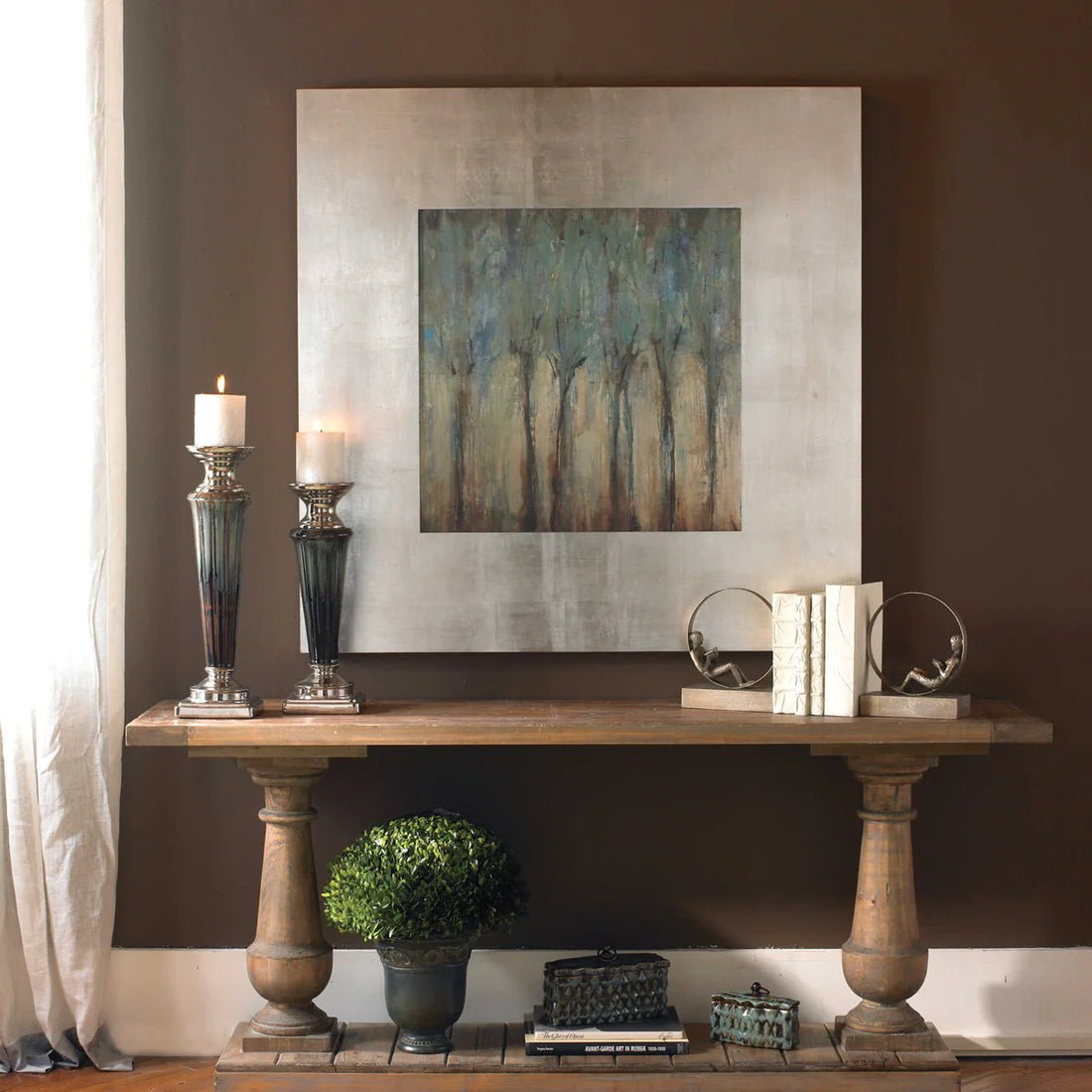
How To Choose the Perfect Wall Art for Your Space
Share
Selecting art that complements your home isn't necessarily a natural talent. For some people, tying a room together is the most stressful and difficult part.
What may seem like a harmless question, such as "how do I pair art pieces together?" and "how do I choose the perfect colors for a particular space" can cause tremendous stress depending on the individual.
Although deciding on the style and size of an ideal art set can feel daunting, a few simple tips can help you get the job done.
Whether you're hanging mirrors, dimensional decor, paintings, or decorative shelves, your walls will be the canvas to express your creativity. This guide will help you figure out how to choose art for your home and turn bland walls into a masterpiece.
Considerations Before You Decide
Below are factors that you should consider before choosing art for your wall decor:
Understanding the Difference Between Paintings and Prints
There's a difference between prints and paintings, and this may be one of the first steps toward choosing wall art for your home. Some people like to mix and match the two, but you might have a preference and are unaware of it.
That means when searching for places to find the art you like, you can use specific terms that'll take you directly where you want to go.
A painting is a piece of art that someone creates by hand. They typically use acrylic or oil paint to design a canvas or board with a paintbrush.
You can find a painting of anything featuring various modern and traditional styles. One of the most famous styles is abstract, which many contemporary decor styles feature.
On the other hand, a print is a copy or exact representation of an original piece. They're available at different prices, some extremely expensive, and limited editions with the artist's signature make them rare and collectible. For those who are on a budget, some fine art prints are affordable on canvas.
With technological advances, prints can be high-quality, featuring excellent attention to detail and vivid colors.
Choosing a canvas art print can stretch over a wood frame, which adds presence and depth. For gallery-wrapped prints with images that continue to wrap around the side of the artwork look fantastic on walls and don't require a frame.
You can also find artwork on metal, wood, fabric, and MDF board, which can add texture to a room.
Easy Tips For Choosing The Perfect Artwork For Your Home
Initially, when figuring out how to choose wall art for your home, you first have to determine the kind of space you have to decorate. You will want to get the sizing together precisely right, so you will need a tape measure.
For instance, how much wall space do you have to work with? You may want to search for large-scale art if you have a larger wall space. Large pieces can have a dramatic effect on a given space.
Evaluating what's currently in your space, such as color, pattern themes, and style will help you determine what goes with what you already have. Before buying new wall art for a specific room, keep in mind the furniture and decor you already have.
If you have a neutral color, it can be used to brighten a room up. Conversely, search for more subdued art pieces if you have lots of texture, color, and pattern.
Size
When you want to decorate a whole room with various art pieces, you must consider the size. Begin with the larger pieces and work your way to smaller pieces of art. Make sure to fill in any gaps that may develop along the way.
For example, begin with the larger piece. Let's say you want a large statement piece directly above your sofa—start here. As you work down to the smaller pieces, they will naturally begin to make sense together.
You can make a room thrive by prioritizing wall art and emphasizing a color from the piece to repeat in rugs, throw pillows, blankets, and of course, paint.
What Size Art Pieces Should You Choose?
When you're unsure, go for the bigger piece! Filling up a space with one stunning artwork is more cohesive and may be easier to tie the room together than if you have a small piece to hang on a large wall. It will look like you're making a strong and intentional decor statement.
Generally, you want to fill the open space on your wall between 57 to 75 percent. For example, if you have a wall that won't have furniture placed against it, that's around 55 inches tall and 120 inches wide, you'd want to get a singular piece, or a group of pieces, that span between 55-72 inches tall and 68-90 inches wide.
If furniture like a credenza or a couch is placed against the wall, you have less open space available, and you'll adjust your measures according to the space left outside the furniture.
Large/Oversized: If the frame of an art piece is between 80-100 long, that falls under the category of a larger artwork. Usually, people use these as the centerpiece in the living room or bedroom.
You can also choose an oversized piece for your home that is longer than one meter. These paintings or prints look fantastic above a couch or dining room table.
Medium: An artwork is medium-sized when it's around 60-80 cm long. This size is the most versatile because you can use one piece to stand alone as the focal point of a room, or you can add two pieces to a gallery wall.
Small/Mini: A small frame is usually 45-60 cm long, and a mini frame is 25-40 cm. A fun way to use these items for your wall decor is to group them and create a gallery wall. Combining three to six small frames in a uniform style gives a dynamic effect and adds depth to the room.
Keep things proportional: You don't want your pictures to be overwhelmingly longer than your couch. The general limit that most interior designers stick to is two-thirds.
Don't go too high or too low: Wall art should be no less than 15 cm above the top of the furniture. Also, keep the ceiling height in mind when figuring out the spacing for your wall decor.
Color
Another tactic for choosing the perfect wall art is using the existing color scheme in your home. And it's not that you have to match everything so that you can't add any art piece outside your scheme, but it's a good starting point.
If you like neutral colors, you don't have to choose artwork with all neutral colors, but you can grab a few that feature those colors prominently and then work your way out and choose a few that add a pop of color here and there. It adds a nice contrast!
Two Methods
Expanding on using existing colors to pick your wall art, there are two primary ways that you can approach it.
The first method is to use accent hues. You'll choose one to two colors you showcase throughout the room and allow them to guide you toward the art pieces that will work best in the space.
It makes the room appear cohesive and consistent while adding contemporary, sophisticated results. You can even play around with various tones and shades of colors to add depth without going too far in the opposite direction.
The other way to use existing colors is to select bold colors. Choose the most prominent color in that room, and add artwork of varying shades and tones for that one color. You could also pick colors that are complementary according to the color wheel.
This tactic allows you to mix and match colors that look great together while going as dark or bright as you'd like to express.
Style/Themes
Here are some of the popular prints that you'll usually see hanging in someone's home and the type of vibes they give off when you add them to your space:
Animals: Animal prints can make your space look cute, sophisticated, or modern.
Transportation: Industrial and urban decor styles can benefit immensely from prints that feature trains, planes, cars, bikes, motorcycles, etc. You can even select vintage travel posters for a more personal touch.
Botanical: Plants, trees, and flowers are often the focal point of many famous pieces of art purely because it's refreshing, can brighten up a room, and fits perfectly with traditional or modern home decor.
Abstract: Playing around with different colors, textures, and shapes go well with pretty much any interior decor style, plus they help you express your taste.
Typography: Typography is becoming increasingly popular as people with eclectic, bohemian, contemporary, industrial, and urban decor styles use words and symbols to express their preferences.
Dimensional
Adding texture and depth to your home decor through dimensional wall art is a bold choice that can pay off nicely.
Adding 3D pieces to your home as the focal point or on a gallery wall is perfect for industrial and modern spaces. Using vintage metal, sculptures, and more can work wonders in a living room or home office.
Functional
You can add useful home decor wall art and get beautiful and functional all in one.
Here are a few suggestions for your home decor that look terrific on walls:
- Shelves: If you need a place to store your books anyway, why not choose a decorative wall shelf which can add sophistication? You could also use them to display vases, candles, framed photos, and other accents.
- Hooks: Choosing wall hooks can be an excellent way to add style to a room, as they come in various finishes and designs, and you can use them for your hats, coats, keys, and bags.
Mirrors
Mirrors are a stylish way to not only check your appearance before you leave a room but also to add reflected light to a room and to create a statement piece to bare walls.
You can find different mirror shapes and sizes with various frame styles. You can group them, use them alone, or even within a gallery wall.
Conclusion
Wall art draws people's attention when they enter a room and can pull a space together nicely by making your home look inviting and tasteful.
Trying to find, purchase, and install art pieces in your home can be daunting, but you can search for unique home decor online to help you get an idea of what you like.
There aren't any specific rules to help you adorn the walls of your home, but if you adhere to these tactics, you should be able to add your personality and uniqueness to any room.
Choosing artwork based on style, theme, colors, and even the floor plan means you have infinite options at your disposal.
